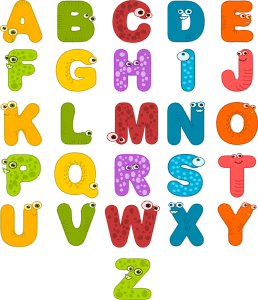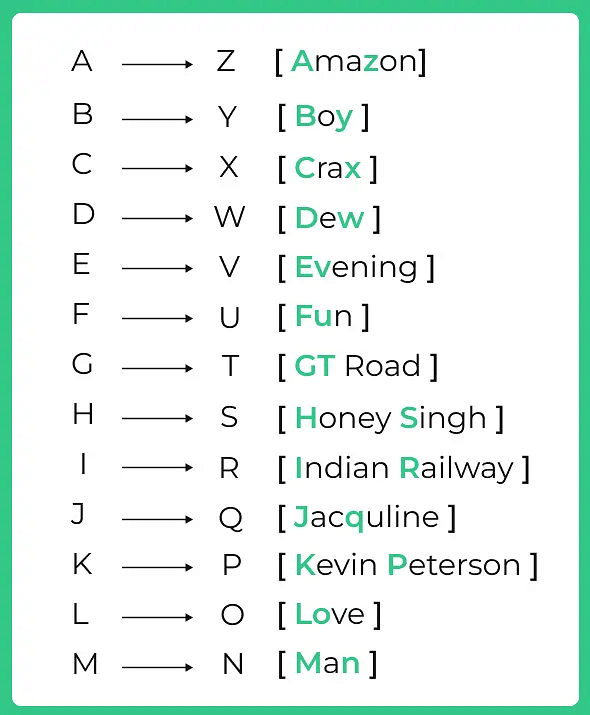Alphabet Reasoning: Concepts & Tricks | Logical Reasoning (LR) and Data Interpretation (DI) - CAT PDF Download
| Table of contents |

|
| Introduction |

|
| Key Concepts |

|
| How to Solve Alphabet Test-related Questions? |

|
| Various types of alphabet reasoning: |

|
| Examples |

|
Introduction
It involves questions based on the position of letters in the alphabet, their sequence, and their relationships. Alphabet reasoning is a common topic in competitive exams.

Key Concepts
1. Alphabet Positioning:
- Each letter has a specific position in the alphabet. For example, A = 1, B = 2, ..., Z = 26.
2. Reverse Positioning:
- The position of a letter in the reverse alphabet. For example, A = 26, B = 25, ..., Z = 1.
3. Skipping Letters:
- Questions may involve skipping a certain number of letters to form patterns or sequences.
4. Coding-Decoding:
- Letters can be coded based on their positions, positions reversed, or by applying specific rules (e.g., shifting letters by a certain number.
How to Solve Alphabet Test-related Questions?
To solve alphabet test-related questions, you can use the following tricks and tips:
- Placing the letters in the forward order
- Placing the letters in the backward order
- Rearranging the letters when the first half is in the backward order
- Rearranging the letters when the second half is in the backward order
- Multiplying the letter segment in the backward order
- The number of the letter is in between two letters only
Aspirants also consider other methods for solving alphabet test-related questions:
- When dealing with number series alphabets, focus on the last digit of each number instead of adding 1 to the second digit.
- "Left - left" refers to the left end, while "right - left" is from the left.
 Alphabet Tricks
Alphabet Tricks
Various types of alphabet reasoning:
1. THE ALPHABET:
The English alphabet contains 26 letters, as given below:
A B C D E F G H I J K L M N O P Q R S T U V W X Y Z
From A to M, the alphabet completes the first 13 letters that is the first half, while the second half starts from 14th letter that is it starts from N and ends at Z.
(First Alphabetical Half) A to M ⇒ 1 to 13
(Second Alphabetical Half) N to Z ⇒ 14 to 26
2. Concept of EJOTY:
The positions of alphabets can be remembered with the help of this simple concept, you can easily find out the position of any letter without much effort. But it is advisable that you learn the positions of different letters in the alphabet.| E | J | O | T | Y |
| 5 | 10 | 15 | 20 | 25 |
Example: We are asked to find the 24th letter from the left side of the alphabet.
We already know that the 25th letter from the left-hand side is Y, now we need to find letter before Y and that is X.
By using this simple method, we can easily find out the position of any letter in the alphabet.
Memorizing the positions & sequence of letters is a basic to solve any questions of this type, so you should try to memorize these positions. For this particular reason, you should practice EJOTY.
- Write down the names of ten of your friends & do as given below:
Let us take an example of name RAVI. - With the help of EJOTY, we know that the letter R stands for number 18, A stand for 1, V stands for 22, I stands for 9.
- Adding all these numbers, we get (18+1+22+9).
- This is a very good way to remember the positions of all the letters in the alphabet.
3. Positions of letters from Right Hand Side (RHS):
Many a times we get questions in the tests that ask us the position of a letter from the right hand side. Although we are in a habit of counting from the left side of the alphabet & not from the right hand side of the alphabet. We are discussing this by taking an example and then we will make a mathematical formula.
Suppose there is a row of 8 persons in which a person is standing 5th from left. Let's find out his/her position from the right side.
| I | I | I | I | I | I | I | 1 |
| 1st | 2nd | 3rd | 4th | 5th | 6th | 7th | 8th |
- You can see that the person who was standing fifth from the left hand side is placed fourth from the right side.
- Suppose there are ‘n’ persons, the order can be horizontal (from left to right) or vertical (from top to bottom) and if the position of a person is given which is rth from left then his position from right will be (n+1-r).
- Likewise this concept can also be used if their sitting order is vertical. Sum of positions from left and from right will always be (n+1). As given in the above mentioned example there are 8 persons, position of 5th person from left will be 4th (8+1-5)from right.
- Sum of both the positions is (4 + 5) = 9. If we are dealing with letters & we are given the position of any letter from either side, we need to add 1 more to the total number of letters & then subtract the position from left side to get its position from the right side.
For instance, let us find the position from right side of a letter, which is the 10th from left side.
| A | B | C | D | E | F | G | H | I | J | K | L | M | N |
| 1 | 2 | 3 | 4 | 5 | 6 | 7 | 8 | 9 | 10 | 11 | 12 | 13 | 14 |
| O | P | Q | R | S | T | U | V | W | X | Y | Z | from LHS |
| 15 | 16 | 17 | 18 | 19 | 20 | 21 | 22 | 23 | 24 | 25 | 26 | from RHS |
- As you can see, the 10th letter from the left hand side of the alphabet is J, which is 17th letter (26+1-10) from the right hand side of the alphabet.
- We did this operation by adding 1 to the total number of letters (26 + 1 = 27) and then subtracting 10 from it.
4. Finding the central symbol/letter/digit:
Many a times the question asks the middle letter/digit in the sequence given e.g. find the middle letter between the 12th letter and the 20th letter from the left hand side of the alphabet.
| A | B | C | D | E | F | G | H | I | J | K | L | M |
| 1 | 2 | 3 | 4 | 5 | 6 | 7 | 8 | 9 | 10 | 11 | 12 | 13 |
| → |
| N | O | P | Q | R | S | T | U | V | W | X | Y | Z |
| 14 | 15 | 16 | 17 | 18 | 19 | 20 | 21 | 22 | 23 | 24 | 25 | 26 |
| → |
You can see that there are 7 letters between these 2 positions i.e. M, N, O, P, Q, R and S. We know that the midpoint of 7 items is the 4th item from either of the sides, whether counted from the right hand side of the alphabet or the left hand side of the alphabet. It comes out to be P, which is the correct answer in this particular case.
5. Fill in the blank Series
These types of series consist of small letters which follow a specific pattern or series. Some spaces are left blank in between the series given. We have to fill in the blanks from given options to make a pattern. This can be clearly explained by this illustration:Illustration: pq_ _ qpp_ _ pq _
1. ppppp
2. ppqpp
3. ppqpq
4. qppqq
Examples
Example 1: Find the Letter
Question: What is the 5th letter to the right of the 10th letter from the left in the English alphabet?
Solution:
- The 10th letter from the left is J (since A=1, B=2, ..., J=10).
- The 5th letter to the right of J is O.
Answer: O
Example 2: Reverse Alphabet Position
Question: What is the reverse position of the letter M?
Solution:
- The position of M in the alphabet is 13.
- The reverse position is 26 - 13 + 1 = 14.
Answer: N
Example 3: Coding-Decoding
Question: If in a certain code, 'CAT' is written as 'XZG', how is 'DOG' written in that code?
Solution:
Analyze the code transformation:
- C (3) -> X (24): 26−3+1=24
- A (1) -> Z (26): 26−1+1=26
- T (20) -> G (7): 26−20+1=7
Applying the same transformation to 'DOG':
- D (4) -> W (23): 26−4+1=23
- O (15) -> L (12): 26−15+1=12
- G (7) -> T (20): 26−7+1=20
Answer: WLT
Practice Questions
Find the Letter:
- What is the 8th letter to the left of the 15th letter from the right in the English alphabet?
Find the Letter:
15th letter from the right is L (since Z=26, Y=25, ..., L=15).
8th letter to the left of L is D.
Answer: D
- What is the 8th letter to the left of the 15th letter from the right in the English alphabet?
Reverse Alphabet Position:
- What is the reverse position of the letter S?
Reverse Alphabet Position:
The position of S is 19.
The reverse position is 26 - 19 + 1 = 8.
Answer: H
- What is the reverse position of the letter S?
Coding-Decoding:
- If in a certain code, 'HELLO' is written as 'SVOOL', how is 'WORLD' written in that code?
Coding-Decoding:
'HELLO' -> 'SVOOL' (Reverse alphabet coding).
'WORLD' -> 'DLIOW'.
Answer: DLIOW
- If in a certain code, 'HELLO' is written as 'SVOOL', how is 'WORLD' written in that code?
Skipping Letters:
- Find the 4th letter after every second letter in the sequence 'ABCDEFGHIJK'.
Skipping Letters:
Sequence after skipping: 'ADGJ'.
Answer: G
- Find the 4th letter after every second letter in the sequence 'ABCDEFGHIJK'.
Mixed Sequences:
- What letter is in the middle of the 7th letter from the start and the 8th letter from the end of the alphabet?
Mixed Sequences:
7th letter from the start is G.
8th letter from the end is S.
The letter in the middle between G and S is M.
Answer: M
- What letter is in the middle of the 7th letter from the start and the 8th letter from the end of the alphabet?
|
77 videos|180 docs|96 tests
|
FAQs on Alphabet Reasoning: Concepts & Tricks - Logical Reasoning (LR) and Data Interpretation (DI) - CAT
| 1. How can one approach solving alphabet test-related questions effectively? |  |
| 2. What are some common types of alphabet reasoning questions that one may encounter in exams? |  |
| 3. How can one improve their skills in solving alphabet reasoning questions? |  |
| 4. Are there any specific tips or tricks that can aid in solving alphabet test-related questions quickly? |  |
| 5. How can one approach challenging alphabet test questions that seem difficult to solve? |  |
















